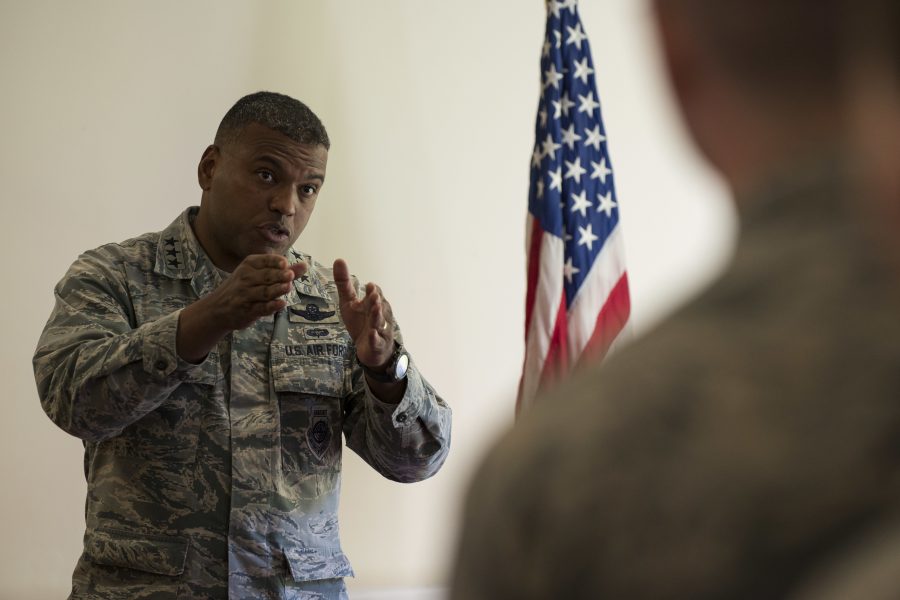The Air Force is crafting new policy that envisions more fluidity between conventional and nuclear weapons, as well as a broader range of options to keep others from using their own nuclear weapons.
The U.S. has long treated conventional and nuclear warfare as separate concepts, but that’s beginning to change, said Lt. Gen. Richard M. Clark, the Air Force’s deputy chief of staff for strategic deterrence and nuclear integration.
Over the past year and a half, nuclear experts on the Air Staff have crafted an overview of “conventional and nuclear integration,” in which American service members must be able to survive a conflict that involves a nuclear weapon.
“The multipolar world is presenting different challenges for us,” Clark said at an Aug. 19 Mitchell Institute for Aerospace Studies event. “The lines are a bit more blurred between conventional and nuclear, so that’s driven us to start thinking in ways that may be different than we thought about in the last 20 years or so.”
A multipolar landscape, where China also poses a top nuclear threat, is the biggest difference from nuclear policy 30 years ago, when defusing tension with Russia was the singular goal, according to Maj. Gen. Michael J. Lutton, who oversees ICBMs as the head of 20th Air Force.
Now, adversaries see conventional and nuclear options as two points on a broader spectrum of conflict, rather than keeping nuclear warfare largely off-limits. Countries like Russia, China, and North Korea seem to understand they are outmatched by America’s non-nuclear bombs and missiles, and are looking for ways to exploit other weaknesses.
“We have to be able to reconstitute our capability. We have to be able to plan and execute integrated operations, multidomain, whether conventional or nuclear, and most importantly, we have to be able to fight in, around, and through that environment to achieve our objectives,” Clark said.
Russia appears to see so-called tactical nuclear weapons as one way to catch the U.S. off-guard in a regional fight, Clark said.
“It is very clear in their doctrine and in the capability, the non-strategic nuclear weapons that they have amassed over the years, it’s evident that that’s in their planning, that’s in their strategy and their thought process,” he said.
China is upgrading its own nuclear arsenal as well. The country has an “ambiguous no-first-use policy,” Clark said, and the U.S. believes China may walk away from that policy for the sake of self-preservation. He added North Korea is another wild card that could bring nuclear weapons to a conventional fight.
The Navy has in response started deploying its own tactical nukes, or those that have shorter ranges and lower yields than the nuclear missiles and bombs now owned by the Air Force and Navy. Experts disagree over whether a distinction should made between tactical and strategic nukes, given the power and long-lasting consequences either would wield. Proponents say tactical nuclear weapons could be an option without escalating to the all-out, last-resort nuclear war envisioned in policymaking.
This approach is different from the nuclear artillery of the Cold War, Clark added.
“What we’re trying to prepare ourselves to do is to respond with whatever force is necessary in a nuclear environment. It’s not so much to fight tactically. Really, the ultimate goal here is to deter,” he said. “We want to raise that threshold of using nuclear weapons, whether strategic or non-strategic … to the highest level possible.”
To do that, Clark argues the Air Force needs ways to stop others from using nuclear weapons in the first place, and options to retaliate if deterrence fails. Technology, training, and command-and-control requirements all need to be updated to support that approach. Legacy weapon systems are part of the puzzle, not just new designs, he said.
His remarks come as the Air Force marks 50 years since it placed the first Minuteman III intercontinental ballistic missile—the most recognizable Cold War weapon—on alert at Minot Air Force Base, N.D., on Aug. 19, 1970. Those ICBMs will be replaced starting in the late 2020s with Northrop Grumman’s Ground-Based Strategic Deterrent, a modern nuclear missile that could eventually accommodate steerable, hypersonic warheads.
The Air Force is also spending billions of dollars on new nuclear cruise missiles, gravity bombs, and bomber aircraft to replace aging systems, arguing it would be more costly and less effective to update the existing assets and unsafe to ditch them altogether. It will also add nukes to dual-capable aircraft like the F-35 Joint Strike Fighter for more flexibility.
Clark left open the idea that the Air Force could create a non-nuclear version of the Long-Range Standoff Weapon cruise missile. The service has dismissed that suggestion in the past because it is already buying Joint Air-to-Surface Standoff Missile variants with increasingly longer ranges.
“Whether limited or large-scale nuclear, we have to be able to fight through that along the full spectrum of conflict,” Clark said. “That’s why we, as an Air Force and really the Department of Defense, are looking at this concept so we can be prepared to address the threat.”
The Air Force will send a capstone report to Congress and the Defense Department on its efforts to move conventional and nuclear integration ideas forward, and is shaping its acquisition plans accordingly, he added.

